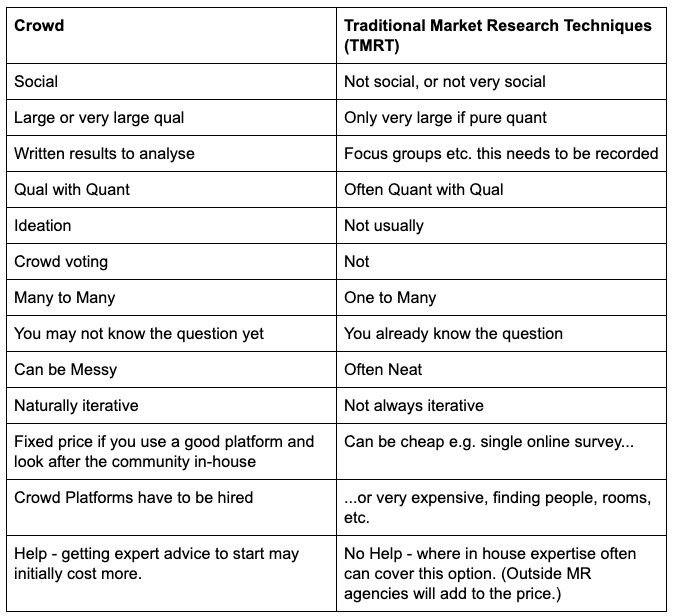Crowdsourcing vs. Traditional Market Research

When Might You Choose a Crowd Over Traditional Market Research Techniques?
If you would like particular input or feedback on your product or service, and want to listen to your customers, clients or staff, when would you choose to run a crowd over traditional methods of market research?
There is a summary of the points discussed in this blog in the table at the end, to help you decide.
Traditional Market Research Techniques (TMRT), e.g. Interviews, Surveys and Focus Groups, work really well for projects where you want to know the answers to particular questions you already know you’d like answers to, especially surveys.
Crowds are great when you don’t even know what the questions should be. The nature of the interaction between crowd members means that all sorts of ‘unknown unknowns’ or new angles come out – you need to spot them as they emerge.
Using TMRT you can collect large or very large amounts of quantifiable data, or even large amounts of many-to-one qualitative data, but not large amounts of many-to-many conversations. (The exception to this is social listening – but you are not shaping the conversation there in any way). With a crowd – you can easily capture in writing the many-to-many conversations for later analysis of content, trends, emotions and so on.
TMRT are not generally a sociable experience, or not a longer term social experience. The exception to this is the long term ‘brand community’ a very useful type of crowd, but an ongoing expense.
For a shorter term crowd – the crowd can meld, make friends, influence each other, and behave in ways that in TMRT they cannot. In our experience, the crowds where the reason to come together is to discuss products or brands are the crowds where this type of friendly interaction happens most naturally.
In TMRT you can transpose and analyse focus group and interview articulations – but with a crowd, that conversation is had in writing to begin with. Participants do not have to have the conversation in real time, but they can log in and chat away following up on anything written to them, anytime. They can also chat in real time, it’s hard to tell the difference between staggered conversations and real time ones.
With TMRT, if you want ideas – you can of course ask people in a survey if they have any ideas about a subject – then take a look at the ideas. These could be great ideas, but you won’t know if anyone else thinks they are great and you won’t know if anyone else would have voted for that idea. You also won’t know if someone else could add something fantastic to that idea to make it even better. All these things are possible with a crowd.
Sometimes it’s not so much about great ideas, but about those ideas revealing something previously untapped about how the crowd see your existing product or service.
Asking for ideas can also reveal negatives or problems with your product that you had not previously considered.
Crowd V Social Listening
Would a crowd be a substitute for Social Listening?
If you want to find completely spontaneous commentary on a topic, place, product or service then social listening is your way to go – there is no substitute for eavesdropping on social chat for an honest opinion.
But if you want to know various and several things from a group of people then a crowd is a good way to marshall this. You do not need to direct the conversation on a crowd in any way, or, you can shape the conversation to what’s most useful. You can also make the conversation iterative, keep putting back to the crowd what you feel you’ve learned from them to check. Many crowd platforms now have an integral survey function, so if you’d like quantitative numbers, put back your crowd findings as a survey to them.
You could ask about a whole field or specific thing and wait to see where the conversation takes the crowd. Ask the crowd to have ideas about how to improve services to find out where a service may need improving. We’ve found that asking the right question is an art form!
Be careful how you incentivise your crowd, the more valuable, or cumulatively valuable, the incentives are, the more crowd members may feel they need to please you with an answer you seem to like, or you want to hear, rather than be honest. (This is different from an upfront competitive idea challenge, where you have to be super-clear about the process and the judging arrangements.)
Get a crowd together who care deeply about your topic and you either won’t need to incentivise them at all, or at least not in a way where they feel they are competing with each other for ‘winnings’.
Most organisations do not have in house expertise on running crowds, but that is something 100%Open can take you through as we work together, and then you can take forward yourself in the future.
Now, that table I promised you:
If you’d like to get in touch, please email me, katie@100open.com

As an addition to this blog post we noticed that IdeaScale have published a free to use infographic on the topic of “When to use a survey and when to use crowdsourcing” you’ll find it here: https://ideascale.com/resource/infographic-surveys-vs-crowdsourcing/